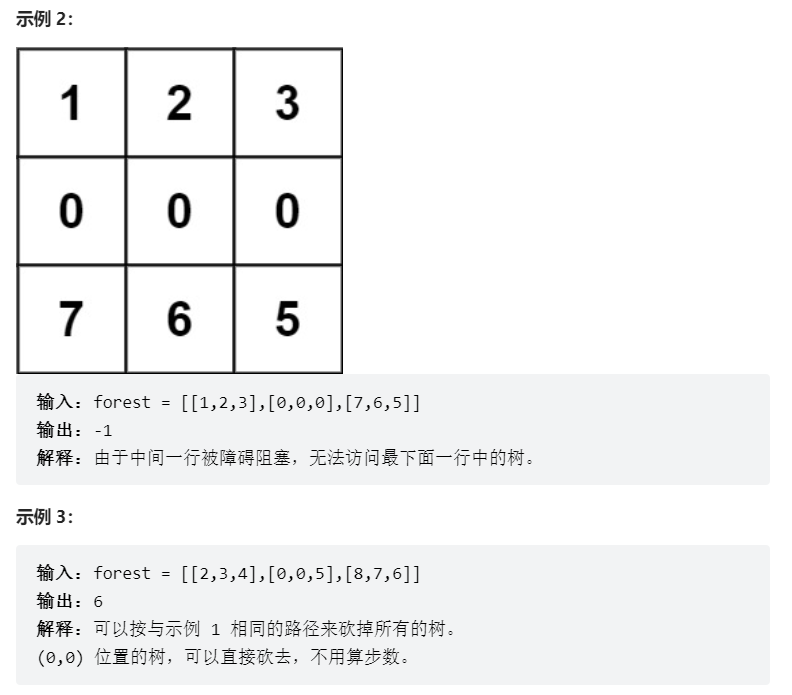1.题目
你被请来给一个要举办高尔夫比赛的树林砍树。树林由一个 m x n 的矩阵表示, 在这个矩阵中:
- 0 表示障碍,无法触碰
- 1 表示地面,可以行走
比 1 大的数 表示有树的单元格,可以行走,数值表示树的高度
每一步,你都可以向上、下、左、右四个方向之一移动一个单位,如果你站的地方有一棵树,那么你可以决定是否要砍倒它。
你需要按照树的高度从低向高砍掉所有的树,每砍过一颗树,该单元格的值变为 1(即变为地面)。
你将从 (0, 0) 点开始工作,返回你砍完所有树需要走的最小步数。 如果你无法砍完所有的树,返回 -1 。
可以保证的是,没有两棵树的高度是相同的,并且你至少需要砍倒一棵树。

提示:
- m == forest.length
- n == forest[i].length
- 1 <= m, n <= 50
- 0 <= forest[i][j] <= 109
来源:力扣(LeetCode)
链接:https://leetcode.cn/problems/cut-off-trees-for-golf-event
著作权归领扣网络所有。商业转载请联系官方授权,非商业转载请注明出处。
2.思路
这里需要理解题目的意思,题目中需要从低到高砍掉所有的树,路过树可以选择不砍。我们要求的是砍掉所有树的最小步数,由于从低到高执行,所以我们可以依次将所有的树的高度排序记录其位置,然后按照这个顺序计算相邻树之间的最小距离,使用广度优先搜索来获得相邻两个位置的最小距离。
3.代码
class Solution {public:int direct[4][2] = {{-1,0}, {1,0}, {0,-1}, {0,1}};int bfs(int bx, int by, int ex, int ey, vector<vector<int>> forest){if(bx == ex && by == ey)return 0;int m = forest.size(), n = forest[0].size();vector<vector<int>> visit(m, vector<int>(n, 0));int step = 0;visit[bx][by] = 1;queue<pair<int,int>> q;q.emplace(bx,by);while(!q.empty()){step++;int qz = q.size();for(int i = 0; i < qz; i++){auto[x, y] = q.front();//cout << x <<" "<<y<<endl;q.pop();for(int j = 0; j < 4; j++){int tx = x+direct[j][0], ty = y + direct[j][1];//cout << tx <<" "<<ty<<endl;if(tx>-1&&tx<m&&ty>-1&&ty<n){if(!visit[tx][ty]&&forest[tx][ty]>0){if(tx == ex && ty == ey)return step;//cout << "tx:" <<tx<<" ty:"<< ty<<endl;q.emplace(tx,ty);visit[tx][ty] = 1;}}}}}return -1;}int cutOffTree(vector<vector<int>>& forest) {int ans = 0;vector<pair<int, int>> trees;for(int i = 0; i < forest.size(); i++){for(int j = 0; j < forest[0].size(); j++){if(forest[i][j] > 1){trees.emplace_back(i, j);}}}sort(trees.begin(), trees.end(), [&](const pair<int,int> &a, const pair<int, int> &b){return forest[a.first][a.second] < forest[b.first][b.second];});int x = 0, y = 0, step;for(int i = 0; i < trees.size(); i++){step = bfs(x, y, trees[i].first, trees[i].second, forest);//cout <<"bx:"<<x<<" by:"<<y<<" ex:"<<trees[i].first<<" ey:"<<trees[i].second <<" "<<step << endl;if(step == -1)return -1;ans += step;x = trees[i].first;y = trees[i].second;}return ans;}};
此方法的时间复杂度和空间复杂度都比较高,后续还需优化。

